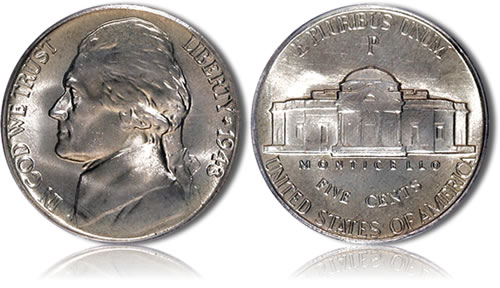Today, 1942-1945 Silver Jefferson War Nickels are desirable for two reasons. First, nickels of this era that are of collectible quality have a numismatic value that can easily reach into the hundreds of dollars per coin.

Second, those that are of inferior quality still have a "junk silver coin" value. That term, while technically a misnomer, just means that the coin has no real value to collectors, but its intrinsic value is worth much more than its face value because of the silver contained within them.
Jefferson Nickel Silver Melt Values
Silver Jefferson Nickels weigh 5.00 grams, with 35% of the composition in silver (see full coin specifications below). The intrinsic value of these silver coins can vary dramatically based on the current spot price of the precious metal. For example, silver closed out the year of 2009 at $16.99 an ounce. At that price, the melt value of the silver contained within one of these War Nickels would have been $.96 — almost twenty times its face value. Jump ahead just several months… Silver continued to climb and it reached a price of $23.53 an ounce on October 13, 2010. At that level, one of these nickels would have a melt value of $1.32.
Of course, values change daily based on spot silver and what the current market dictates. Local coin dealers and auction sites are a good place to determine the current value of Jefferson nickels. The online auction site eBay is one such example with thousands of coin listings available at all times. Some sample listings of the War Nickel are shown below:
Silver Jefferson Nickel Information
The 1942-1945 Silver Jefferson War Nickel owes its creation to the realities of war.
With the United States firmly engaged in battle on several fronts during World War II, the resources available to the country were becoming more and more limited. Aside from the common shortages of the time like rubber, sugar, coffee, etc., the United States also struggled to obtain enough raw materials for the production of the equipment needed for battle. A prime example of this is the metal nickel which was desperately needed for use in the manufacturing of armor plating used on everything from tanks to planes.
Such an important use for the limited amounts of the metal nickel demanded changes in the everyday uses of it. One of those changes came in the form of the circulated coinage of the country.
Nickel had been used in some of the United States coins since before the American Civil War. However, its inclusion in a five-cent piece beginning in 1866 (called the Shield type nickel composed of 75% copper and 25% nickel) started a series of the coins that would continue to use the metal until the demands of war required its removal in 1942.
With the war industry in desperate need for all available supplies of the metal, Congress ordered the United States Mint to discontinue its use in the five-cent coin, which by this time had attained the nickname of "nickel" owing to the inclusion of the metal in its composition.
The United States Mint complied with the Congressional order and beginning on October 8, 1942 started issuing the five-cent "nickels" with a new composition containing the precious metal silver. Each new five-cent coin was now struck from 56% copper, 35% silver and 9% manganese. Interesting though it may be that a precious metal such as silver was of less use to the country than a base metal like nickel, that change of composition (which lasted three years until the end of 1945) today offers collectors yet another opportunity to obtain silver containing coins.
Each new silver Jefferson Nickel still featured the same basic obverse and reverse designs as they had since 1938. In that year, the obverse of the five-cent piece was changed to contain a portrait of former President of the United States Thomas Jefferson, as designed by Felix Schlag. The reverse, also done by Schlag, showcased an image of Jefferson’s estate in Virginia known as Monticello.
However, as it was widely believed that these coins would be withdrawn from circulation after the war to be melted down again for their silver, each reverse design now featured a very large mint mark above the dome of Monticello. An "S" indicated the coin was struck at the U.S. Mint’s facility in San Francisco, a "D" indicated the coin was struck at the Mint’s facility in Denver, and for the first time ever on a coin from the US Mint, a "P" indicated that the coin was struck at the Mint’s facility in Philadelphia. Previous to this specific strike, and until 1979, Philadelphia struck coins had no mint mark.
1942-1945 Silver Jefferson War Nickel Specifications
| Face Value: | $.05 |
| Composition: | 56% copper, 35% silver, 9% manganese |
| Total Mintage: | 869,896,100 |
| Diameter: | 21.2 mm |
| Weight | 5 grams |
| Edge: | Plain |
| Minting Facility: | Philadelphia (P), Denver (D) & San Francisco (S) |
| Obverse Design: | portrait of Thomas Jefferson |
| Obverse Designer: | Felix Schlag |
| Reverse Design: | image of Monticello, Jefferson’s home |
| Reverse Designer: | Felix Schlag |